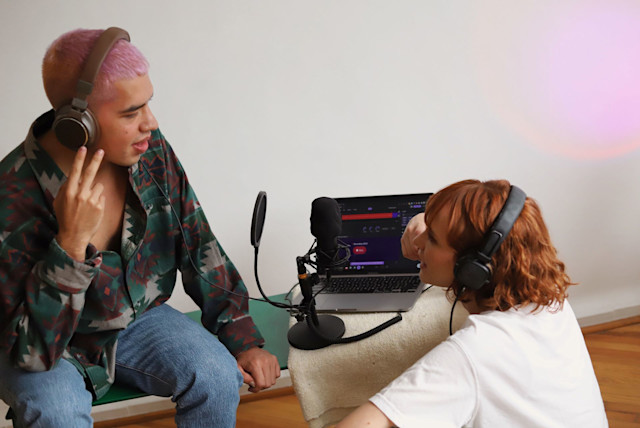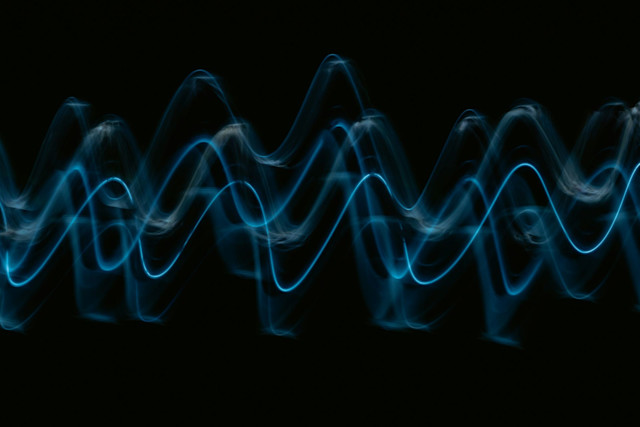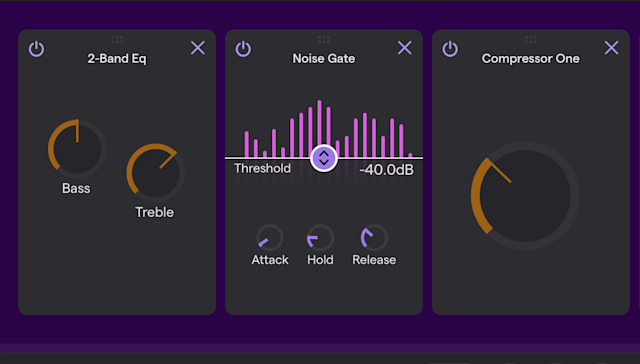Noise Gate: Explained
September 20, 2024 - Need to filter out background noise, or isolate and reduce an unwanted sound? Then it’s time to learn how to use a noise gate!

A noise gate (also known as an audio gate) is a music production tool that has the ability to mute a signal that is below a defined threshold.
You may still be asking: So, what does it do?
A noise gate’s primary function is to get rid of background sounds. But it is also commonly used to get rid of audio spill, which is fancy verbiage for… “Oops, my mic just picked up an unwanted sound from an instrument or amp” Or “That wasn’t supposed to be in this recording!”.
Noise gates work by ‘closing the gate’ once a frequency hits a certain point.
What is a Noise Gate and How Does it Work?
A noise gate (also known as an audio gate) is a music production tool that has the ability to mute a signal that is below a defined threshold.
You may still be asking: So, what does it do?
A noise gate’s primary function is to get rid of background sounds. But it is also commonly used to get rid of audio spill, which is fancy verbiage for “Oops, my mic just picked up an unwanted sound from an instrument or amp” Or “That wasn’t supposed to be in this recording!”.
Noise gates work by closing the gate once a frequency hits a certain point. By adding this to a signal path, you can clean up the sound and make it nice. Many times, you can eliminate an unwanted buzz or timbre entirely.
In the Context of A Wavelength
Let’s say that we have a rumbling or humming sound that we need to get rid of. Just for a second, imagine your audio signal as one big wave; its shape rises up to a peak, like a parabola. The wave reaches a high part (called the crest) and then falls back down. This happens over and over again, and we call it the wave cycle.
Realistically, our audio is going to be comprised of many waves, unless you are putting a gate on a single-line/one-note instrument and on one track only. However, I find it easiest to imagine it this way.
As the audio gets quieter and the unwanted sound starts to peak through, this is when we start to get to the downward slope (close to the the trough of the wavelength). Here is where our noise gate will come in. The noise gate would visually look like a horizontal line that will ‘cut off’ this part of the wavelength.
How high or low you set the gate will determine what stays, and what goes. It can be placed anywhere an unwanted sound is- just so long as it doesn’t cut out any of the ‘main meat’ of your audio.

Noise Gate Pedals
If you’re a guitarist, you may own a noise gate pedal. Similar to the noise gate inside of a given DAW, noise gate pedals aid instrumentalists by removing unwanted noises. For bass or guitar, a noise gate pedal may remove amp sounds, hissing, and other signals once they drop down to a certain volume
Noise Gate Vs. Compression
Noise gates may seem similar to compressors, but they’re not exactly the same. Compression will affect everything, and a noise gate will only open the door (so to speak) once the volume becomes low enough. Compressors smooth down a recording's rough edges, like sandpaper might to the sprues of an injection-molded art piece. It also can enhance or increase the volume of certain areas of the mix and make tracks like vocals become the focal point.
Noise gates close the door to unwanted tones once the mix is quiet enough to showcase them. A compressor is the increaser and a noise gate is the decreaser, if you think about it in a certain sense. The beauty of using noise gates is that they hide some of the audio’s sins and make everything feel squeaky clean.
Noise Gate Vs. Reduction
Noise gate: Either it is on or it is off
Noise reduction: On all of the time
Noise gate does not distort sounds
Noise reduction always distorts sounds (at least a bit)
Noise gate and noise reduction are also two very different things. While a noise gate is more like a light switch that would turn on and off, noise reduction is something that is always on.
Noise reduction tools are usually based on an algorithm, but can result in a distorted signal. Technically, cleanup tools always distort the signal, but when its a good one- Like this AI powered vocal cleanup tool- you won’t be able to hear it! Noise gates don’t distort the given signal because they’re not changing it, they’re just cutting it off at a certain point.
Tools Inside a Noise Gate
Some of the main controls that you will see inside a noise gate include: hold, release, threshold, and attack.
Hold determines how long this ‘door’ is going to be open. Release, on the other hand, determines how gradually the door goes from open to closed. You can think of it as a fade-out for the tool.
The threshold is the place where the noise gate is going to start to register sound. I like to think of it like the threshold inside Photoshop. When you’re turning an image into a cartoon effect, you get to choose how much the effect will change your original photograph. The amount you turn the dial can change the entire exposure and feeling (sound!). Threshold is what volume won’t be allowed to pass through.
The attack is how quickly the door opens: I think of it like the shutter speed on a camera. Just a small tweak to the attack and the entire photo is completely changed. If the shutter on a camera is too slow, and the end result can be messy. The same goes for an attack inside a noise gate, if it comes in too gradually, it won’t sound natural.
Noise Gate: Quick Tips
Here on some quick tips and creative ideas on how to use the noise gate in a DAW.
Start with a quick attack, and dial it down if you need to
Don’t put the threshold right on the line where the noise is: Put it a tiny bit above and give the sound some leeway
Experiment with different noise gate attacks depending on the instrument: Vocals will need a different treatment than say, drums (In vocals, even the sound of the breath needs to be considered)
Try putting your nose gate first: add compression and FX later
Give the hold some time, that way it’s not jarring. If you hear wackiness, lengthen the hold for up to 40-50ms and go from there
If you’re looking to use a noise gate on vocals specifically, check out this in-depth article by The Music Mixing Guy.
When Not to Use It
While the noise gate might be starting to sound like a magic tool you’re going to want to use on everything- It’s not.
Don’t use a noise gate on a delicate recording with a wide dynamic range that goes from soft and emotive to big and bold. As long as the recording sounds good when it’s soloed, keep it as-is. If it’s not and it has background noise? It’s probably best to just re-record it.
Why?
If you begin meddling with attacks in a vocal recording that has a wide range of volume, it may begin to sound unnatural. Or (even worse) some of the quiet parts of the recording could end up getting cut out entirely. Remember that if you already have a perfectly emotive yet dynamic recording, less is often more.
Scenarios Where It’s Most Helpful
Recorded sessions
To improve the quality of live drums
To clean up live performances in real-time
Make informally-recorded podcasts sound more crisp
The louder and rowdier the genre/recording, the more difficult it can be to get a clear result. Jam-band-style recordings with bombastic guitars and percussion are the first thing that comes to mind. A basic noise gate can go a long way in taking your basement recording sessions and turning them into radio-ready hits.
It’s no secret that some of the most difficult instruments to record live are drums. There’s a reason why a lot of producers have bands come in live, and then they switch the drum out for electronic ones. But you don’t have to do it like that. Live drums have a reputation for being difficult to record well- but if you know how to use a noise gate, the process will be a lot more rewarding.
Live performers also benefit from this tool. Routing the signal(s) through a noise gate pedal first can ensure that listeners in the crowd have a crisp listening experience.
Many podcasters have to record in non-studio environments. So what is one to do if there’s a dog barking, or lawnmower running?
Yep, again, add a noise gate!
Soundtraps’ Noise Gate

With Soundtrap Premium, you can quickly and easily clean up your audio in a cloud-based DAW. This noise gate has attack, hold, and release dials that can be adjusted as you go.
A good middle-of-the-road setting to start with here might be a 5Ms attack, a 30Ms hold, and a 100 Ms release. This noise gate may also be used in tandem with other FX. I’m particularly fond of the FX and workflow in this DAW since I can see all my effects and where they are at during production.
Try Out a Noise Gate on Your Recordings!
No matter if you are a podcaster, rock artist, or even a classical musician, you can benefit from this simple production tool. Try out Soundtraps’ premium noise gate tool for free today.
About the author
Aleah Fitzwater is a multi-instrumentalist, songwriter, music journalist, and blogger from Temperance, United States. Aleah holds a Pk-12 instrumental music education degree. Her main instruments are flute, piano, drums, bass, and guitar.
Get started with Soundtrap today!